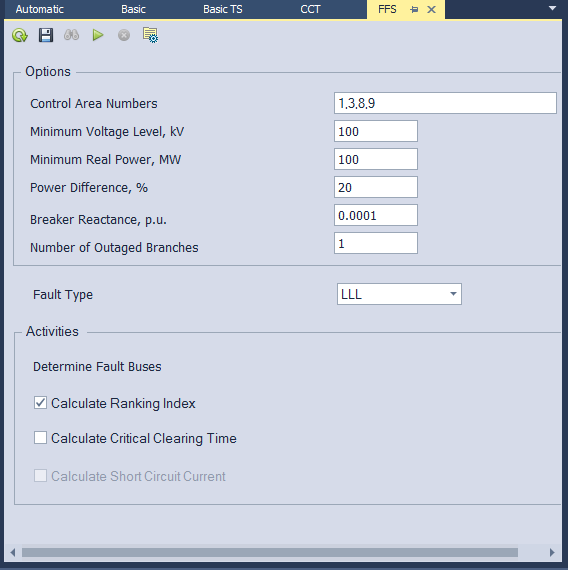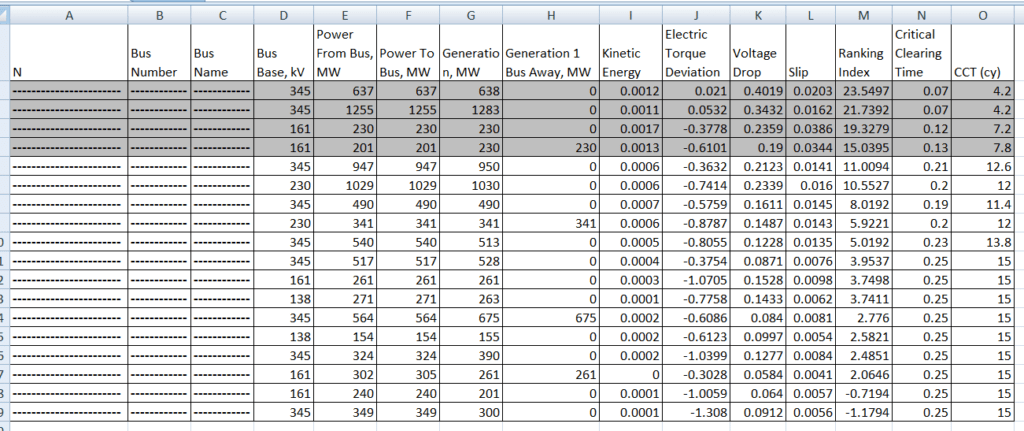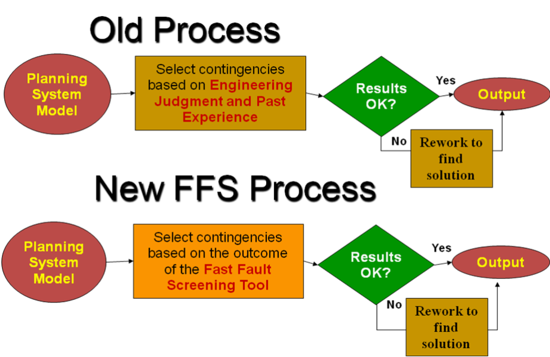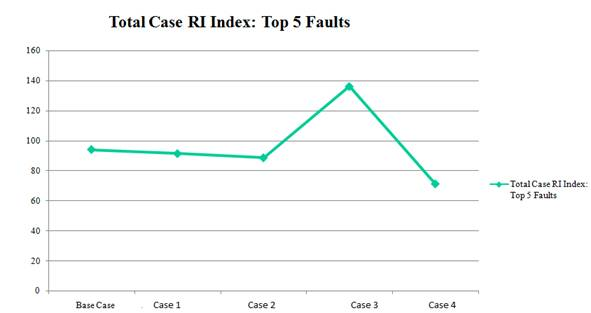Fast Fault Screening (FFS) – Identify and Rank the Most-Severe Faults
Fast Fault Screening (FFS) tool, which is a part of the POM-transient stability (TS) tool, is fully integrated with POM. FFS quickly scans thousands of potential transmission fault locations and identifies the most severe for TS studies. These are the weakest points in the transmission network.

FFS analysis is performed in three steps:
- Selecting the most-severe fault locations.
- Ranking of the most-severe faults using ranking index (RI).
- Calculating critical clearing time (optional).
FFS performs these steps consecutively within the same run.
During the first step of analysis, the most-severe faults are identified using the heuristic approach. These faults are then ranked using the RI. The index is an analytical tool with the coefficients derived using regression analysis. The RI provides a very fast approximation of the fault severity but does not require running time-domain simulation. The larger value of the RI corresponds to a more-severe fault.
Fault severity is classified as follows (starting with the most severe situation):
- Post-fault regime does not exist (i.e., steady-state instability).
- Loss of generation.
- Situations corresponding to faults with small critical clearing time.

It takes under one minute to determine the most-severe fault locations and rank these faults. Thus, FFS reduces run time for planning studies and allows for bringing TS analysis into a real-time environment.
FFS has the capability to rank three-phase as well as unbalanced faults.
The TS analysis process involving FFS is described below:

FFS capability is a part of the TS module. FFS computations are executed from the FFS Tab. There are fourprebuilt activities in the FFS:
FFS activities for determining three-phase faults are:
- Determine critical buses
This activity scans the network and identifies the most severe fault locations.
- Determine and rank critical buses
The activity identifies the most severe fault locations and ranks them based on the RI.
- Compute CCT for critical buses
The activity automatically computes the critical clearing time (CCT) for the most-severe fault locations.
For unbalanced fault calculations an additional, forth activity is available. Activity Calculate Short Circuit Current computes short circuit current during unbalanced fault calculations.
Use of the FFS tool for NERC TPL compliance studies
Traditionally, utility planners analyze pre-determined, “must-run” contingencies to test their system for stability issues. These contingencies are mainly based on engineering judgment and past experience. This requires running full blown time domain simulations, which is a time-consuming task. In addition, there is a possibility of missing a few scenarios that may have been overlooked following changes in the system. The problem can be acerbated for systems with existing or planned high levels of wind energy, which may result in more-severe TS problems. These studies are very time-consuming since they utilize time domain simulation at different locations based on engineering judgment and may also miss key problem areas. Power system planners need a faster way to assess grid stability and identify the most severe fault locations under different system conditions. Therefore, it becomes important to develop an analysis framework for TS studies that offers fast and robust computations to significantly decrease computational time and save man-hours to perform TS analysis. The studies will facilitate NERC-compliance studies and enable power system planners to enhance the level of transmission grid reliability.
FFS for has been used by Entergy for NERC-compliance studies since 2007. SERC 2007 audit report recognized Entergy’s proactive efforts in utilizing the innovative methodology.
Direct benefits reported by Entergy include:
- Reduction in computation time of at least 50% on average.
- Saving about 300 man-hours for NERC Reliability Standards compliance-related studies.
- Using a practical tool to perform TS studies required under the NERC standard TPL-001-4.
Entergy reported that “FFS is a first of its kind tool in the industry and a powerful one for finding stability problems in large and complex power systems”, [1, 2]. Entergy has been using the FFS for TPL compliance since 2007, [3]. At the end of 2013, V&R Energy performed an FFS study with FFS as a part of SPP’s NERC TPL compliance process, [4].
The NERC Standard TPL-001-4 Requirement 2, Part 2.4.3 requires that “the sensitivity analysis in the planning assessment must vary one or more of the following conditions by a sufficient amount to stress the system within a range of credible conditions that demonstrate a measurable change in performance.”
Use of the FFS tool in operations
FFS may be also used to compare various scenarios in terms of TS limitation, such as transfer scenarios (or various EMS cases).This capability was utilized during a project with NYISO “Fast Fault Screening for Real-Time Transient Stability Assessment.” [5] FFS is performed for each case, and then a case comparison is made based on the RI value for the case. The case with the highest RI is the most-severe case. The figure shows that Case 3 is the most severe case in terms of TS limitation.

FFS may be also used to rank unbalanced faults. There are two options to rank unbalanced faults:
- Based on the RI (from TS perspective); and
- Based on the short circuit current magnitude (from short circuit perspective).
References:
- “Entergy Pioneers Use of Fast Fault Screening Tool to Identify Severe Contingencies for Transient Stability Studies,” EPRI Innovators, 2009.
- “Entergy Pioneers Use of Fast Fault Screening Tool to Identify Severe Contingencies for Transient Stability Studies ,“ Sharma Kolluri, EPRI PSAPO Area Council Meeting, 2009.
- “NERC Compliance Effort Using POM-OPM and POM-TS (Entergy’s Experience),” Presentation by Entergy, 2012 POM Users Group Meeting, April 2012.
- “SPP Experience Using POM Fast Fault Screening for NERC TPL Assessments,” Presentation by SPP, 2014 POM Users Group Meeting, April, 2014.
- “Fast Fault Screening for Real-Time Transient Stability Assessment,” NYSERDA Final Report 10-34, 2010.

